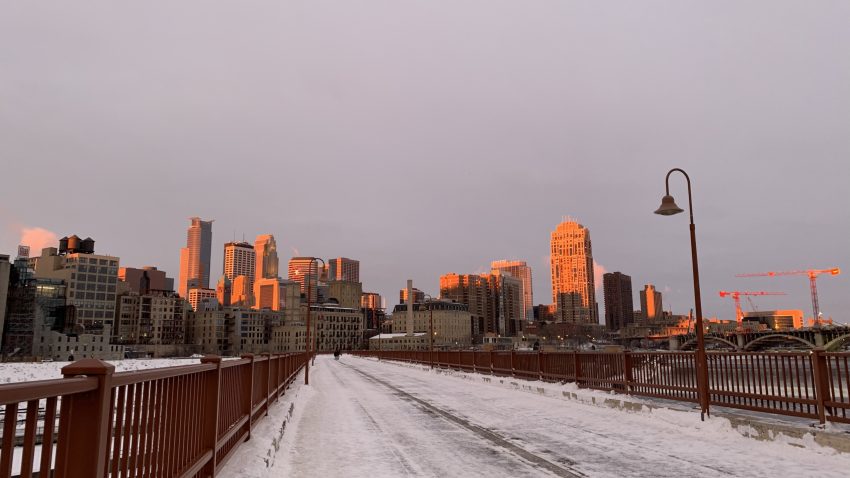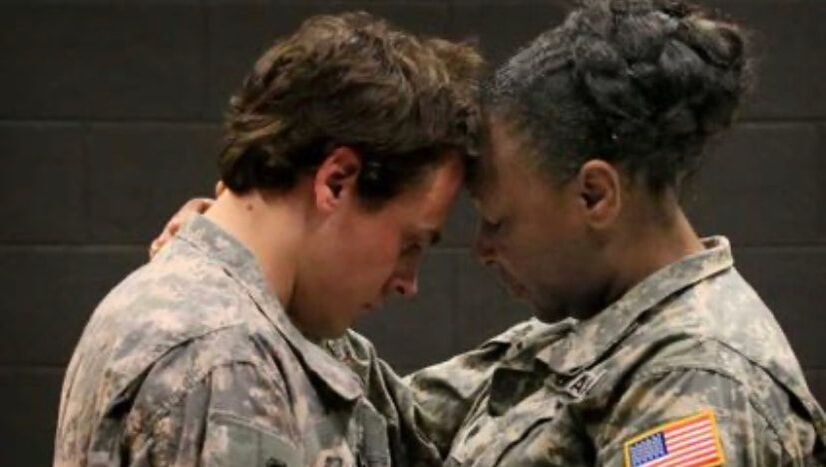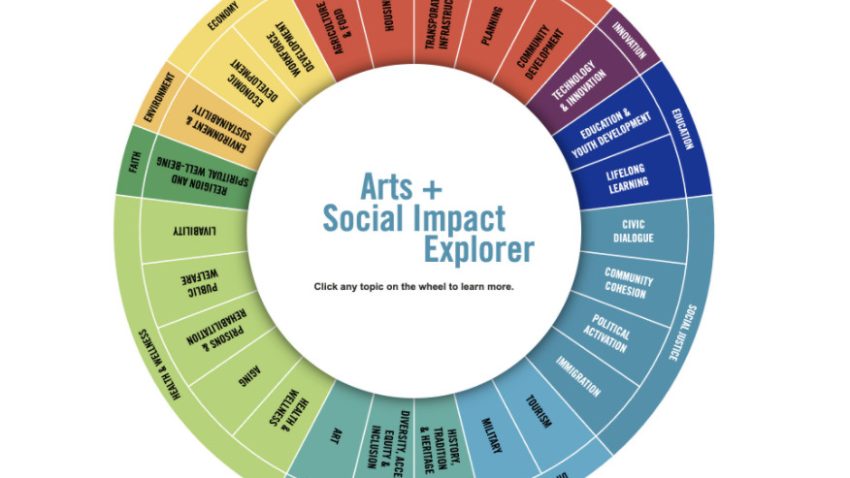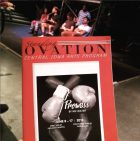Although our four weeks of interim are drawing to an end, Democracy and the Arts is not the kind of class one can simply tie a neat little bow on and back away, not to be seen again for years. The work done in this class with hopefully ripple out into the world for weeks, months, or even years into the future.
It was admittedly disappointing when our adventures in Washington, D.C. had to be transitioned online, but I tried to not let my dampened excitement get in the way of a good  opportunity. After all, “Zoom University” opens the way for other interactions we may not have had otherwise, such as meeting with the MN State Arts Board or chatting with Senator Tina Smith. I also got to spend the month exploring life in Minneapolis with my boyfriend. Waking up and watching the sunrise over the city from Stone Arch Bridge is a remarkable sight. Pair it with a coffee and an art walk through the Mill District, and you are set to have an excellent day.
opportunity. After all, “Zoom University” opens the way for other interactions we may not have had otherwise, such as meeting with the MN State Arts Board or chatting with Senator Tina Smith. I also got to spend the month exploring life in Minneapolis with my boyfriend. Waking up and watching the sunrise over the city from Stone Arch Bridge is a remarkable sight. Pair it with a coffee and an art walk through the Mill District, and you are set to have an excellent day.
One of the best outcomes of this class has been my renewed confidence in my future career path. I have never been one to let the stigma of being a theater major stop me, but seeing people succeed in the field is always reassuring. Over the month, I compiled a spreadsheet of organizations in D.C. and across the nation that I would like to work with down the road. In particular, after chatting with Elizabeth Dale-Denies from the Smithsonian American Art Museum, I looked into more positions like her contract with the Department of Defense Education Activity and was shocked to find a fair amount of programs. I will be spending several years, post-graduation, on bases across the country and would be thrilled to find an intersection between military life and theater. One such group I found and plan in reaching out to is ArtsUp! in LA. They offer service members the opportunity to share their stories through Veteran Empowerment Theater workshops, giving them space to be creative and heard. I think national defense and theater is just one of the less considered intersections Democracy and the Arts allowed me to explore.
would be thrilled to find an intersection between military life and theater. One such group I found and plan in reaching out to is ArtsUp! in LA. They offer service members the opportunity to share their stories through Veteran Empowerment Theater workshops, giving them space to be creative and heard. I think national defense and theater is just one of the less considered intersections Democracy and the Arts allowed me to explore.
This class reaffirmed my understanding that the arts and democracy can never be truly separate. Unless the artwork is overtly political, creativity is rarely seen as an active participant in the workings of the state. The fine arts are considered ‘extra’ or ‘unnecessary’ much of the time, but this month introduced us to people working to change the minds of a nation in that regard. Randy Cohen at Americans for the Arts gave us insight into the economical significance art engagement has in the United States. The social impact wheel below is used as an educational tool by the organization when showing how fine arts reach every corner of our lives, whether obvious or not.  To little surprise, during the times of COVID, health and wellness see some of the largest impacts. Randy also reminded us of the influence statistics have when making a persuasive argument, a useful tip for our upcoming project proposals. To quote St. Olaf Alumni, Allison Offerman, “If you have no numbers, you have no opinion.” It is a harsh outlook, but one that has benefited those looking to gain support, especially the monetary kind. Personally, I believe more funding for creatives would always be fantastic, but above all, recognition for the art’s societal influence is critical for artists to thrive.
To little surprise, during the times of COVID, health and wellness see some of the largest impacts. Randy also reminded us of the influence statistics have when making a persuasive argument, a useful tip for our upcoming project proposals. To quote St. Olaf Alumni, Allison Offerman, “If you have no numbers, you have no opinion.” It is a harsh outlook, but one that has benefited those looking to gain support, especially the monetary kind. Personally, I believe more funding for creatives would always be fantastic, but above all, recognition for the art’s societal influence is critical for artists to thrive.
Another theme that became apparent this interim is the privileges we each hold. As a student at a relatively prestigious college, it would be irresponsible to ignore the privilege my degree will grant me. We mentioned early on, the majority of the U.S. adult population does not hold a bachelor’s degree or higher, making having one a major advantage. I firmly believe in using my edge to lift under-recognized voices. It has always been the plan to work on projects that aim to make a change in the community. My favorite theater productions have a social justice message and are paired with an insinuative. In 2018, I saw Prowess by Ike Holter, at the Stoner Theater in Des Moines and I felt incredibly m oved by the intensity and boldness of the performance. My friend and I sat in a small audience of primarily older white Midwesterners for the duration of the show. Prowess highlights the effects of gang violence in Chicago, and it was clear, by the talkback session afterward, that most did not quite grasp the messages beneath the surface level. Nevertheless, they were in some way moved. The presentation nudged them out of their comfort zone just enough to make them think critically. In these days of rapid social change, art is like a guiding hand for those who need to expand their view.
oved by the intensity and boldness of the performance. My friend and I sat in a small audience of primarily older white Midwesterners for the duration of the show. Prowess highlights the effects of gang violence in Chicago, and it was clear, by the talkback session afterward, that most did not quite grasp the messages beneath the surface level. Nevertheless, they were in some way moved. The presentation nudged them out of their comfort zone just enough to make them think critically. In these days of rapid social change, art is like a guiding hand for those who need to expand their view.
The metaphor, “Art is a mirror of society,” has and will forever be true. Historians rely greatly on what artists have captured to retell the stories of our ancestors. Prof. Epstein made the point, “History is not what happened, it is what was recorded.” I had never thought of the past in that light. My parents are historians, and I had always seen history as a quest for absolute truth, or as close as one can come to absolute truth. It is, of course, impossible to understand exactly what occurred, even if you lived through the event. Art is a means of record keeping. In theater, we examine plays written hundreds of years ago and speculate what audiences of the day experienced, but interpretations can vary greatly. This is an obstacle the curators, like the many we spoke to at various Smithsonian, have to navigate. They hold the authoritative power in telling America’s stories. A carelessly put-together exhibit could send the wrong narrative that could go on to circulate until corrected in later years.
I could say so much more, but deadlines, deadlines, deadlines… I will end on this thought. The past month has been challenging, but at the same time reassured me that I made the correct decision when I committed to being a theater major at St. Olaf. We talked to so many people who are making it in the arts, even if not in the position as they originally planned. With everything said, I am now more confident that I will be able to ‘zig-zag’ my way to a career in the arts.
